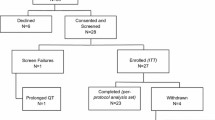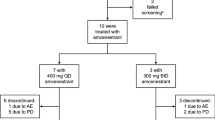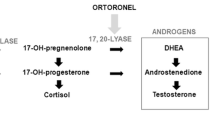Abstract
Purpose: Raloxifene is a second-generation selective estrogen receptor modulator that reduces the incidence of breast cancer in postmenopausal women. Exemestane, a steroidal aromatase inhibitor, decreases contralateral new breast cancers in postmenopausal women when taken in the adjuvant setting. Preclinical evidence suggests a rationale for coadministration of these agents to achieve complete estrogen blockade. Experimental design: We tested the safety and tolerability of combination exemestane and raloxifene in 11 postmenopausal women with a history of hormone receptor-negative breast cancer. Patients were randomized to either raloxifene (60 mg PO daily) or exemestane (25 mg PO daily) for 2 weeks. Patients then initiated combination therapy at the same dose levels for a minimum of 1 year. Pharmacokinetic and pharmacodynamic data for plasma estrogens, raloxifene, exemestane, and their metabolites were collected at the end of single-agent therapy and during combination therapy. Results: Plasma concentration–time profiles for each drug were unchanged with monotherapy versus combination therapy. Raloxifene did not affect plasma estrogen levels. Plasma estrogen concentrations were suppressed below the lower limit of detection by exemestane as monotherapy and when administered in combination with raloxifene. The most common adverse events of any grade included arthralgias, hot flashes, vaginal dryness and myalgias. Conclusions: In this small study, coadministration of raloxifene and exemestane did not affect the pharmacokinetics or pharmacodynamics of either agent to a significant degree in postmenopausal women. The combination of estrogen receptor blockade and suppression of estrogen synthesis is well tolerated and warrants further investigation.








Similar content being viewed by others
References
Clemons M, Goss P (2001) Estrogen and the risk of breast cancer. N Engl J Med 344:276–285
Cauley JA, Lucas FL, Kuller LH et al (1999) Elevated serum estradiol and testosterone concentrations are associated with a high risk for breast cancer. Study of Osteoporotic Fractures Research Group. Ann Intern Med 130:270–277
Osborne CK (1998) Tamoxifen in the treatment of breast cancer. N Engl J Med 339:1609–1618
Early Breast Cancer Trialists’ Collaborative Group (1998) Tamoxifen for early breast cancer: an overview of the randomised trials. Lancet 351:1451–1467
Fisher B, Costantino JP, Wickerham DL et al (1998) Tamoxifen for prevention of breast cancer: report of the National Surgical Adjuvant Breast and Bowel Project P-1 study. J Natl Cancer Inst 90:1371–1388
Fisher B, Costantino JP, Wickerham DL et al (2005) Tamoxifen for the prevention of breast cancer: current status of the National Surgical Adjuvant Breast and Bowel Project P-1 study. J Natl Cancer Inst 97:1652–1662
King MC, Wieand S, Hale K et al (2001) Tamoxifen and breast cancer incidence among women with inherited mutations in BRCA1 and BRCA2: National Surgical Adjuvant Breast and Bowel Project (NSABP-P1) Breast Cancer Prevention Trial. JAMA 286:2251–2256
Cuzick J (2002) First results from the International Breast Cancer Intervention Study (IBIS-I): a randomised prevention trial. Lancet 360:817–824
Cuzick J, Powles T, Veronesi U et al (2003) Overview of the main outcomes in breast-cancer prevention trials. Lancet 361:296–300
Black L, Sato M, Rowley E (1994) Raloxifene (LYI39481 HCI) prevents bone loss and reduces serum cholesterol without causing uterine by-pertrophy in ovariectomized rats. J Clin Invest 93:63–69
Delmas PD, Bjarnason NH, Mitlak BH et al (1997) Effects of raloxifene on bone mineral density, serum cholesterol concentrations, and uterine endometrium in postmenopausal women. N Engl J Med 337:1641–1647
Ettinger B, Black DM, Mitlak BH et al (1999) Reduction of vertebral fracture risk in postmenopausal women with osteoporosis treated with raloxifene: results from a 3-year randomized clinical trial. Multiple Outcomes of Raloxifene Evaluation (MORE) Investigators. JAMA 282:637–645
Cummings SR, Eckert S, Krueger KA et al (1999) The effect of raloxifene on risk of breast cancer in postmenopausal women: results from the MORE randomized trial. Multiple Outcomes of Raloxifene Evaluation. JAMA 281:2189–2197
Cauley JA, Norton L, Lippman ME et al (2001) Continued breast cancer risk reduction in postmenopausal women treated with raloxifene: 4-year results from the MORE trial. Multiple Outcomes of Raloxifene Evaluation. Breast Cancer Res Treat 65:125–134
Cummings SR, Duong T, Kenyon E et al (2002) Serum estradiol level and risk of breast cancer during treatment with raloxifene. JAMA 287:216–220
Lippman ME, Krueger KA, Eckert S et al (2001) Indicators of lifetime estrogen exposure: effect on breast cancer incidence and interaction with raloxifene therapy in the Multiple Outcomes Of Raloxifene Evaluation study participants. J Clin Oncol 19:3111–3116
Martino S, Cauley JA, Barrett-Connor E et al (2004) Continuing outcomes relevant to Evista: breast cancer incidence in postmenopausal osteoporotic women in a randomized trial of raloxifene. J Natl Cancer Inst 96:1751–1761
Vogel VG, Costantino JP, Wickerham DL et al (2006) Effects of tamoxifen vs raloxifene on the risk of developing invasive breast cancer and other disease outcomes: the NSABP Study of Tamoxifen and Raloxifene (STAR) P-2 trial. JAMA 295:2727–2741
Gruber CJ, Tschugguel W, Schneeberger C et al (2002) Production and actions of estrogens. N Engl J Med 346:340–352
Simpson ER, Dowsett M (2002) Aromatase and its inhibitors: significance for breast cancer therapy. Recent Prog Horm Res 57:317–338
De Jong P, Van de Ven J, Nortier J et al (2002) Inhibition of intratumoral aromatase and estradiol by exemestane in postmenopausal breast cancer patients: results of a double blind randomized study [abstract 268]. Breast Cancer Res Treat 76:S76
de Jong P, van de Ven J, Nortier H et al (1997) Inhibition of breast cancer tissue aromatase activity and estrogen concentrations by the third-generation aromatase inhibitor vorozole. Cancer Res 57:2109–2111
Buzdar A, Howell A (2001) Advances in aromatase inhibition: clinical efficacy and tolerability in the treatment of breast cancer. Clin Cancer Res 7:2620–2635
Miller WR (1999) Biology of aromatase inhibitors: pharmacology/endocrinology within the breast. Endocr Relat Cancer 6:187–195
Miller WR, Dixon JM (2002) Endocrine and clinical endpoints of exemestane as neoadjuvant therapy. Cancer Control 9:9–15
Miller W, Dixon J, Grattage L, Stuart M, Hocdtin-Boes G (1999) Effects of neoadjuvant treatment with the aromatase inhibitor, anastrozole (Arimidex) on peripheral and in situ estrogen synthesis and uptake by breast tissue in postmenopausal women. Paper presented at San Antonio Breast Cancer Symposium, San Antonio, TX, December 8–11, 1999
Miller WR, Dixon JM (2001) Local endocrine effects of aromatase inhibitors within the breast. J Steroid Biochem Mol Biol 79:93–102
Geisler J, King N, Anker G et al (1998) In vivo inhibition of aromatization by exemestane, a novel irreversible aromatase inhibitor, in postmenopausal breast cancer patients. Clin Cancer Res 4:2089–2093
Geisler J, Haynes B, Anker G et al (2002) Influence of letrozole and anastrozole on total body aromatization and plasma estrogen levels in postmenopausal breast cancer patients evaluated in a randomized, cross-over study. J Clin Oncol 20:751–757
Geisler J, King N, Dowsett M et al (1996) Influence of anastrozole (Arimidex), a selective, non-steroidal aromatase inhibitor, on in vivo aromatisation and plasma oestrogen levels in postmenopausal women with breast cancer. Br J Cancer 74:1286–1291
Coombes R, Kilburn L, Snowdon C et al (2007) Survival and safety of exemestane versus tamoxifen after 2–3 years’ tamoxifen treatment (Intergroup Exemestane Study): a randomised controlled trial. Lancet 369:559–570
Goss PE, Ingle JN, Martino S et al (2003) A randomized trial of letrozole in postmenopausal women after five years of tamoxifen therapy for early-stage breast cancer. N Engl J Med 349:1793–1802
The ATAC Trialists’ Group (2002) Anastrozole alone or in combination with tamoxifen versus tamoxifen alone for adjuvant treatment of postmenopausal women with early breast cancer; first results of the ATAC randomised trial. Lancet 359:2131–2139
Lu Q, Liu Y, Long BJ et al (1999) The effect of combining aromatase inhibitors with antiestrogens on tumor growth in a nude mouse model for breast cancer. Breast Cancer Res Treat 57:183–192
Brodie A, Jelovac D, Long BJ (2003) Predictions from a preclinical model: studies of aromatase inhibitors and antiestrogens. Clin Cancer Res 9:455S-459S
Brodie A, Lu Q, Liu Y et al (1998) Preclinical studies using the intratumoral aromatase model for postmenopausal breast cancer. Oncology (Huntingt) 12:36–40
Brodie AH, Mouridsen HT (2003) Applicability of the intratumor aromatase preclinical model to predict clinical trial results with endocrine therapy. Am J Clin Oncol 26:S17–S26
Brodie A (2003) Aromatase inhibitor development and hormone therapy: a perspective. Semin Oncol 30:12–22
Long BJ, Jelovac D, Handratta V et al (2004) Therapeutic strategies using the aromatase inhibitor letrozole and tamoxifen in a breast cancer model. J Natl Cancer Inst 96:456–465
Jelovac D, Macedo L, Handratta V et al (2004) Effects of exemestane and tamoxifen in a postmenopausal breast cancer model. Clin Cancer Res 10:7375–7381
Jelovac D, Long B, Sabnis G et al (2002) Preclinical studies evaluating the anti-tumor effects of exemestane using the intratumoral aromatase postmenopausal breast cancer model. Breast Cancer Res Treat 76:S77
Zaccheo T, Diudici D, di Salle E (1993) Inhibitory effect of combined treatment with the aromatase inhibitor exemestane and tamoxifen on DMBA induced mammary tumors in rats. J Steroid Biochem Mol Biol 44:677–680
di Salle E, Geroni C, Lamparelli M et al (2002) Chemopreventive effect of the aromatase inactivator exemestane combined with the antiestrogen raloxifene in the dimethylbenzanthracene (DMBA)-induced mammary tumors in rats. Am Soc Clin Oncol 21:117a
Ingle J, Suman V, Johnson P et al (1999) Evaluation of tamoxifen plus letrozole with assessment of pharmacokinetic interaction in postmenopausal women with metastatic breast cancer. Clin Cancer Res 5:1642–1649
Rivera E, Valero V, Francis D et al (2004) Pilot study evaluating the pharmacokinetics, pharmacodynamics, and safety of the combination of exemestane and tamoxifen. Clin Cancer Res 10:1943–1948
Baum M, Budzar AU, Cuzick J et al (2002) Anastrozole alone or in combination with tamoxifen versus tamoxifen alone for adjuvant treatment of postmenopausal women with early breast cancer: first results of the ATAC randomised trial. Lancet 359:2131–2139
Hutson PR, Love RR, Havighurst TC et al (2005) Effect of exemestane on tamoxifen pharmacokinetics in postmenopausal women treated for breast cancer. Clin Cancer Res 11:8722–8727
Swain S, Wilson J, Eleftherios M et al (2004) Estrogen receptor status of primary breast cancer is predictive of estrogen receptor status of contralateral breast cancer. J Natl Cancer Inst 9:516–523
Chen Q, Ngui JS, Doss GA et al (2002) Cytochrome P450 3A4-mediated bioactivation of raloxifene: irreversible enzyme inhibition and thiol adduct formation. Chem Res Toxicol 15:907–914
Johannessen DC, Engan T, Di Salle E et al (1997) Endocrine and clinical effects of exemestane (PNU 155971), a novel steroidal aromatase inhibitor, in postmenopausal breast cancer patients: a phase I study. Clin Cancer Res 3:1101–1108
Cenacchi V, Baratte S, Cicioni P et al (2000) LC-MS-MS determination of exemestane in human plasma with heated nebulizer interface following solid-phase extraction in the 96 well plate format. J Pharm Biomed Anal 22:451–460
Hochner-Celnikier D (1999) Pharmacokinetics of raloxifene and its clinical application. Eur J Obstet Gynecol Reprod Biol 85:23–29
Goss P, Bondarenko I, Manikhas G et al (2006) Phase 3 study of atamestane + toremifene vs. letrozole in advanced breast cancer. J Clin Oncol 24:LBA525
Langecker P, Blanchett D, Lang W et al (2002) Phase I, open-label, randomized, crossover study of the pharmacokinetic interaction of toremifene and atamestane (Biomed 777) in healthy postmenopausal women. Paper presented at Breast Cancer Res Treat, San Antonio, TX, December 11–14, 2002
Masamura S, Santner SJ, Heitjan DF et al (1995) Estrogen deprivation causes estradiol hypersensitivity in human breast cancer cells. J Clin Endocrinol Metab 80:2918–2925
Baum M, on behalf of the ATAC Trialists’ Group (2001) The ATAC (Arimidex, Tamoxifen, Alone or in Combination) adjuvant breast cancer trial in postmenopausal women. Breast Cancer Res Treat 69:210
Dowsett M, Cuzick J, Howell A et al (2001) Pharmacokinetics of anastrozole and tamoxifen alone, and in combination, during adjuvant endocrine therapy for early breast cancer in postmenopausal women: a sub-protocol of the ‘Arimidex and Tamoxifen Alone or in Combination’ (ATAC) trial. Br J Cancer 85:317–324
Lonning PE, Bajetta E, Murray R et al (2000) Activity of exemestane in metastatic breast cancer after failure of nonsteroidal aromatase inhibitors: a phase II trial. J Clin Oncol 18:2234–2244
Dimitrakakis C, Zhou J, Wang J et al (2003) A physiologic role for testosterone in limiting estrogenic stimulation of the breast. Menopause 10:292–298
Barrett-Connor E, Mosca L, Collins P et al (2006) Effects of raloxifene on cardiovascular events and breast cancer in postmenopausal women. N Engl J Med 355:125–137
Vogel VG, Costantino JP, Wickerham DL et al (2003) National Surgical Adjuvant Breast and Bowel Project update: prevention trials and endocrine therapy of ductal carcinoma in situ. Clin Cancer Res 9:495S–501S
Acknowledgments
Editorial support was provided by Gerard P. Johnson, PhD, at Complete Healthcare Communications, Inc., and was funded by Pfizer Inc. This study was partially funded by Pfizer Global Pharmaceuticals, New York, NY.
Author information
Authors and Affiliations
Corresponding author
Rights and permissions
About this article
Cite this article
Traina, T.A., Poggesi, I., Robson, M. et al. Pharmacokinetics and tolerability of exemestane in combination with raloxifene in postmenopausal women with a history of breast cancer. Breast Cancer Res Treat 111, 377–388 (2008). https://doi.org/10.1007/s10549-007-9787-1
Received:
Accepted:
Published:
Issue Date:
DOI: https://doi.org/10.1007/s10549-007-9787-1




